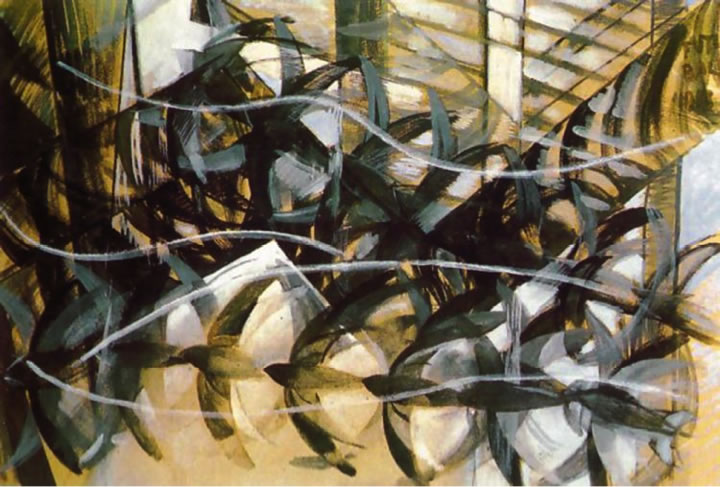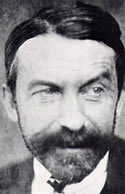
 |
Giacomo Balla, Flight of the Swallows, 1913 His Work: Images | Portfolio | Athenaeum | Artcyclopedia His Life: Guggenheim | WikiP | Artchive | ArtDir | |
(look for elements and traits that repeatedly appear)
Repetition and prominent use of Curves. Curves are the dominating type of line or edge.
Repetition and prominent use of Motif: the bird/swallow motif is the main recognizeable imagery.
Many overlapping shapes serve to connect regions of the composition.
Rhythm itself is a dominating unifying trait... the entire composition is a collection of light-dark rhythms that fade and transition into one another, and contrast with neighboring rhythms.
Regular Bold/Sharp Contrast:
Contrast between each shape is pretty high. Balla creates a dynamic rhythm across the entire canvas with sharp contrasts between dark and light forms. This serves both to unify the composition graphically, but also to establish a pervasive sense of energy as the dominating affect.
A very limited palette of colors unifies the painting.
Colors are mostely warm low-chroma colors. (the original is actually something of a richer orange than illustrated here.)
The other colors are neutrals -- blacks and near-whites.
(look for alignments, structures or groupings that organize parts into larger entities (gestalt))
Repeated shapes are aligned into flowing paths -- which is Balla's tactic for representing motion in a static image.
These paths cause each bird shape to become a part of a larger whole, the progression across the composition.
Left-to-Right Motion:
The paths of the repeating motifs, particularly the swallows.
The sweeping white curves that overlay the repetitious motifs.
The huge zig-zag (dark form) across the center of the composition.
Clarity: Most edges/lines are rather crisp and sharp, though Balla does vary clarity of edge.
Texture is kept moderately rough throughout.
Movement, Movement and Movement.
Energy, action and motion expressed powerfully in a mere, static image.
Powerful graphic rhythms serve to create a dynamic energy.
Balla also uses a degree of abstraction that is easily readable.
His imagery of the swallows is not utterly apparent at first. He leaves the viewer to solve that simple puzzle.
(look for contrast of any and every kind. Look especially for similar forms that are varied in some way. Look for anomalies — patterns or norms that are broken.)
The curves are quite varied and offer a lot of movement and energy.
The repeated elements are nevery precisely repeated, but vary along their path. Also, the waving, curving, flowing quality of the motion paths adds an energy or variety.
Most, if not all, of the rhythms vary and progress somewhat as they move across the composition.
There are important geometric shapes in contrast to the dominating curves.
In contrast to the many curves, there is the huge left-to-right dark zig-zag form across the middle of the painting.
The major focal areas involve sharp points, not flowing curves.
Bold darks against light tones.
These persistent, pervasive contrasts are the main dynamic or source of visual variety throughout the composition.
Cold neutrals against the warm yellow-orange tones.
While the main motion or movement is from side-to-side (horizontal), as established by the path of the swallow, there are several variations on that motion.
TEach white streak is another kind of horizontal traversal of the canvas.
The bolid side-to-side zig-zag movement is a hard, abrupt, geometric variation on the bird's smooth motion.
Light and Dark vary from left to right.
The left side is predominantly dark. The right edge is markedly lighter in contrast.
Thus, a moderate assymetry adds dynamism.
Describe the forms that contribute to their graphic emphasis?
. Major light and dark "points" or "peaks".
The major focal area involves...
...a generally central position, near left-rule-of-thirds position
...most prominent light-dark contrasts, particularly against a scarce light background
...several motion-paths passing through
...and the main imagery (bird/swall motif)
...that bird-shape is the only shape that has very little overlap with other shapes -- it is unusually free and clear of most cluttersome background shapes.
...and the most prominent "peak" due to pronounced value contrast
.
Thus, the bird-peak area just below and left of center is the most emphatic area of the composition.
Overall the composition is relatively even in its busyness — there is an understated hierarchy between focal and relief areas.
Balla keeps the composition very busy and active throughout.
Relief involves areas of less movement, rather than areas of no movement — Balla never offers fully relaxed, calm relief, just varying degrees of activity.
His painting is, after all, all about the action.
The left edge has subdued contrast -- it is mostly dark and calm.
The center passage, from left-to-right, has a bold zig-zag shape, but its coloration has subdued contrast within it.